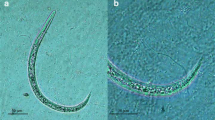Abstract
Angiostrongylus cantonensis is a parasitic pathogen whose forth-stage larvae (L4) parasitize in the central nervous system (CNS) of the human cause severe eosinophilic encephalitis or meningoencephalitis. Previous study indicated an impressive anthelmintic efficacy of tribendimidine (TBD) against CNS parasitized L4 of A. cantonensis. Tegument of the larvae is the first physical barrier to protect them from attack by the host immune system. In the present study, tegumental and hypodermic alterations were observed by scanning electron microscopy and transmission electron microscopy after administration of TBD. During treatment of TBD in vivo, L4 presented wizened side sensor, disappearance of mastoids and longitudinal grain, prominent surface coat, heterogeneous tegumental layers, incompact hypodermic cell junctions, blurred myotube, and small scale of vacuole in a basal layer. After incubation with TBD in vitro, L4 exhibited a swollen side sensor and mastoids disappearance in head end. Abundant tegumental blebs and obvious deformation of both cross-grain and longitudinal grain were detected on the surface, and shrinkage of all tegumental layers, chaotic cell junction, turbid muscle cell, disappearance of myotubes, and vacuole-like changes were visible under the electron microscope. The results implied the potential mechanism of the anthelmintic effect of tribendimidine against L4 of A. cantonensis by direct damages to tegumental and hypodermic.




Similar content being viewed by others
References
Abrahams-Sandi E, Hoffmann WH, Graeff-Teixeira C, Schulz-Key H, Geiger SM (2004) Long-term observations on mouse strains experimentally infected with Angiostrongylus costaricensis. Parasitol Res 93(3):230–234
Chen HT (1935) Un nouveau nematoda pulmonaire: Pulmonema cantonensis, n.g.n. sp. des rats de Canton. Ann Parasitol Hum Comp 13:312–317
Chen KM, Lai SC (2007) Biochemical and pathological evaluation of albendazole/thalidomide co-therapy against eosinophilic meningitis or meningoencephalitis induced by Angiostrongylus cantonensis. J Antimicrob Chemother 59(2):264–276
Courdurier J, Guillon J, Malarde L, Laigret J, Desmoulins G, Schollhammer (1964) Demonstration of the cycle of Angiostrongylus cantonensis in the laboratory: observations on this cycle and anatomo-pathology caused by this parasite in various laboratory animals. Bull Soc Pathol Exot Fil 57(6):1255–1262
Hu X, Li JH, Lan L, Wu FF, Zhang EP, Song ZM, Huang HC, Luo FJ, Pan CW, Tan F (2012) In vitro study of the effects of Angiostrongylus cantonensis larvae extracts on apoptosis and dysfunction in the blood–brain barrier (BBB). PLoS One 7(2):e32161
Hu Y, Xiao SH, Aroian RV (2009) The new anthelmintic tribendimidine is an l-type (levamisole and pyrantel) nicotinic acetylcholine receptor agonist. PLoS Negl Trop Dis 3(8):e499
Ishii AI (1987) Pathogenic factors in the later pulmonary phase of Angiostrongylus cantonensis-infected rats. Parasitol Res 73(5):458–465
Keiser J, Shu-Hua X, Utzinger J (2006) Effect of tribendimidine on adult Echinostoma caproni harbored in mice, including scanning electron microscopic observations. J Parasitol 92(4):858–862
Keiser J, Thiemann K, Endriss Y, Utzinger J (2008a) Strongyloides ratti: in vitro and in vivo activity of tribendimidine. PLoS Negl Trop Dis 2(1):e136
Keiser J, Utzinger J, Xiao SH, Odermatt P, Tesana S (2008b) Opisthorchis viverrini: efficacy and tegumental alterations following administration of tribendimidine in vivo and in vitro. Parasitol Res 102(4):771–776
Lan KP, Lai SC (2009) Differences of proteolytic enzymes and pathological changes in permissive and nonpermissive animal hosts for Angiostrongylus cantonensis infection. Vet Parasitol 165(3–4):265–272
Liu HX, Zhang Y, Lv S, Hu L, Zhou XN (2009) Establishment and observation of the life cycle of Angiostrongylus cantonensis in a laboratory setting. Chin J Pathog Biol 4(11):836–839 (in Chinese)
Pearce EJ, Sher A (1987) Mechanisms of immune evasion in schistosomiasis. Contrib Microbiol Immunol 8:219–232
Ren HN, Cheng BZ, Zhuang ZN (1987) Experimental therapeutic efficacy of a new anti hookworm drug tribendimidine. Chin J Parasitol Parasit Dis 5(4):262–264 (in Chinese)
Wallace GD, Rosen L (1966) Studies on eosinophilic meningitis.2.Experimental infection of shrimp and crabs with Angiostrongylus cantonensis. Am J Epidemiol 84(1):120–131
Wang J, Wei J, Zeng X, Liang JY, Wu F, Li ZY, Zheng HQ, He HJ, Wu ZD (2013) Efficacy of tribendimidine against Angiostrongylus cantonensis infection in the mice. Parasitol Res 112(3):1039–1046
Wang QP, Wu ZD, Wei J, Owen RL, Lun ZR (2012) Human angiostrongyliasis cantonensis: an update. Eur J Clin Microbiol Infect Dis 31(4):389–395
Xiao SH (2004) Tribendimidine—a new anthelmintic. Chin J Parasitol Parasit Dis 22(5):312–315 (in Chinese)
Xiao SH, Wu HM, Tanner M, Utzinger J, Wang C (2005) Tribendimidine: a promising, safe and broad-spectrum anthelmintic agent from China. Acta Trop 94(1):1–14
Xiao SH, Wu ZX, Zhang JH, Wang SQ, Wang SH, Qiu DC, Wang C (2007) Clinical observation on 899 children infected with intestinal nematodes and treated with tribendimidine enteric coated tablets. Chin J Parasitol Parasit Dis 25:372–375 (in Chinese)
Xiao SH, Xue J, Tanner M, Zhang YN, Keiser J, Utzinger J, Qiang HQ (2008) Artemether, artesunate, praziquantel and tribendimidine administered singly at different dosages against Clonorchis sinensis: a comparative in vivo study. Acta Trop 106(1):54–59
Xiao SH, Xue J, Xu LL, Zheng Q, Qiang HQ, Zhang YN (2009) The in vitro and in vivo effect of tribendimidine and its metabolites against Clonorchis sinensis. Parasitol Res 105(6):1497–1507
Yamashita T, Aiba H, Oya H, Fukuda Y (1980) Angiostrongylus cantonensis: development following pulmonary arterial transfers into permissive and nonpermissive hosts. Exp Parasitol 49(3):339–352
Yuan G (2010) Metabolism and disposition of tribendimidine and its metabolites in healthy Chinese volunteers. Drugs RD 10(2):83–90
Zhang JH, Xiao SH, Wu ZX, Qiu DC, Wang SH, Wang SQ, Wang C (2008) Tribendimidine enteric coated tablet in treatment of 1,292 cases with intestinal nematode infection—a phase IV clinical trial. Chin J Parasitol Parasit Dis 26:6–9 (in Chinese)
Acknowledgments
This work was supported by the National Basic Research Program of China (grant no. 2010CB530004) and the National Nature Science Foundation of China (grant nos. 81271855 and 81261160324). We would like to appreciate Professor Guosheng He from the Shanghai Veterinary Research Institute, Chinese Academy of Agricultural Sciences, for his kind gift of tribendimidine.
Author information
Authors and Affiliations
Corresponding authors
Rights and permissions
About this article
Cite this article
Zeng, X., Wang, J., Wei, J. et al. Angiostrongylus cantonensis: tegumental and hypodermic alterations of the fourth-stage larvae following administration of tribendimidine in vivo and in vitro. Parasitol Res 112, 3035–3040 (2013). https://doi.org/10.1007/s00436-013-3479-z
Received:
Accepted:
Published:
Issue Date:
DOI: https://doi.org/10.1007/s00436-013-3479-z




